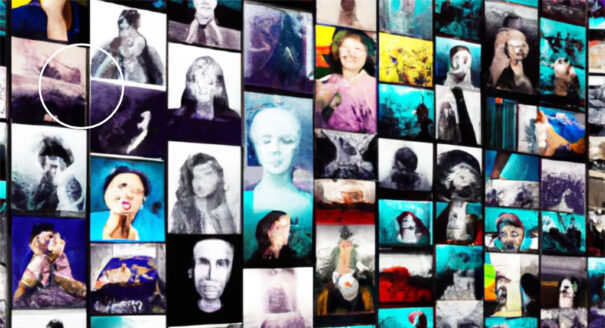Cuatro narrativas inéditas generadas por la Inteligencia Artificial (IA)
Lau Delgado, consultor en Media, reflexiona sobre las narrativas inéditas audiovisuales que pueden generar las tecnologías IA.
El impacto de las tecnologías de Inteligencia Artificial (IA) va mucho más allá de lo que imaginamos. Sus efectos superan con creces el simple debate sobre si el trabajo de los creadores de contenidos será substituido por una máquina. Detrás de todo este proceso, está la posible mutación del modelo productivo y económico de las industrias creativas provocado por las transformaciones en la gestión; en la concepción de la autoría y en la llegada de nuevas narrativas que van mucho más allá de lo que conocemos o nos imaginamos.
La gran diferencia de las tecnologías IA con otras anteriores es que estas permiten un viaje al centro de la obra. Estas nuevas narrativas permiten al usuario viajar a la ubicación en la que pasa la acción, interactuar (si se quiere) con sus protagonistas y ver las partículas de información de cerca, al detalle.
Ante este panorama, propongo que especulemos sobre futuras narrativas que están naciendo gracias a pequeñas experiencias que están dando unos resultados —en el ámbito conceptual— notables. Para llevar este objetivo a buen puerto, me ha parecido oportuno clasificar estas narrativas inéditas como si se trataran de viajes.
1. Narrativa a medida: el viaje a la carta
Comenta un colega especialista en comercio electrónico y usabilidad en internet y plataformas móviles que la industria pornográfica es la que marca la pauta en su sector. Y esta industria lleva años evolucionando el uso de la IA, ya sea para etiquetar sus millones de vídeos como para generar escenas falsas. En definitiva, lo que busca la industria es una experiencia completamente a medida, con los elementos exactos que quiere ver o experimentar el usuario.
Este “viaje” a la carta también puede llegar a ser posible en diferentes sectores del mundo de las industrias creativas, especialmente los que ofrecen un proceso creativo.
The creación a medida puede modificar la concepción de la figura del artista o del autor e incluso la del productor o editor.
¿Podría existir una editorial de libros a la carta? ¿Una colección de libros en la que el usuario decida la tipología de trama, personajes y localizaciones? ¿Y que cada libro sea diferente? Veremos… Lo que sí ya experimentamos actualmente es la creación de vídeos comerciales mediante etiquetas; la creación de ilustraciones a medida: la elaboración ensayos literarios a la carta o la creación de músicas originales a partir de una serie de instrucciones. Todo ello generando una nueva autoría.
La creación a medida puede modificar la concepción de la figura del artista o del autor e incluso la del productor o editor. Factor que transforma, de forma notoria, parte de la organización del modelo de negocio de las industrias creativas. Incluso el usuario cultural puede ser considerado como el autor de aquello que consume. Una paradoja inédita, en nuestro sistema.
2. Narrativa ubicacional: el viaje en el tiempo y el espacio
En el post “Back to the Future: what AI has in common with travel” (editado por Towards Data Science), Tim Gordon reflexiona sobre como la IA puede ayudar a viajar en el tiempo y cuáles son los peligros que entrañaría dicho proceso. Más allá de la parte fantasiosa del post, existe una realidad que conecta la IA con el viaje a otros mundos.
Existe una reality que conecta la IA with the viaje a otros mundos.
Si la tecnología IA es capaz de generar un mundo pasado, futuro o imaginado descrito en un ensayo histórico, novela, película, serie de ficción televisiva o mediante cualquier otra plataforma narrativa, la IA será capaz de recrear este mundo y los usuarios tendremos la posibilidad de interactuar con él; ya sea mediante el texto, el vídeo, tecnología inmersiva, etc. Podremos comentar la jugada con Don Quijote; ser víctimas del mundo represivo de George Orwell en 1984; preparar el hacha de guerra al enano del Señor de los anillos, de Tolkien o compartir setas mágicas con Mario Bros.
Estamos ante la posibilidad de pasar de una experiencia pasiva a otra de activa, en la que se produce la inmersión en mundos imaginados, coherentes y —en ocasiones— referentes de nuestra cultura.
3. Narrativa introspectiva: el viaje interior
El mes de diciembre de 2022 se hizo popular la noticia de una artista (Michelle Huang) que dialogaba con su yo más joven a través de sus diarios y mediante tecnología IA (recomendable la lectura de “Artist trains an AI chatbot with her diary and talks to her inner child”, en The Decoder).
Este tipo de viaje narrativo contiene una conjunción de elementos hasta ahora inéditos en nuestro ecosistema. Se trata de una narrativa introspectiva, interactiva y que permite viajar en el tiempo y en otras ubicaciones. Se trata, pues, de un superviaje que solo se puede producir si el mundo que se tiene que generar ha sido detalladamente relatado en los diarios en una etapa anterior.
Con ciertas narrativas aplicadas a la IA, es posible mantener un diálogo entre las dos edades de la misma persona como si se tratara de una conversación de dos personas que conviven en una misma realidad.
Según se relata en el artículo Jonathan Kemper en The Decoder, es posible mantener un diálogo entre las dos edades de la misma persona como si se tratara de una conversación de dos personas que conviven en una misma realidad.
Dejando de lado el viaje por placer o curiosidad, este tipo de narrativa también puede tener una utilidad educativa y médica. Así como puede suscitar un alto interés sociológico, al permitir el acceso a la forma de pensar de una generación (si se produce una acumulación de casos).
4. Narrativa inductiva: viaje al centro de la tesis
Si la tecnología IA nos permite ubicarnos en espacios generados concretos y dominamos el tempo de nuestra presencia en estos ecosistemas, seremos capaces de conocer mundos y realidades concretas al detalle. Incluso, podemos ser observadores al detalle de las realidades que se nos plantean en las diferentes narraciones, confirmando o negando la tesis de su autor (sea humano o artificial).
A pesar de los temores que suscitan este tipo de tecnologías, en el ámbito creativo, el ser humano siempre tendrá un rol destacado.
Este tipo de rol puede ser especialmente interesante cuando se trata de tesis que están conectadas con la realidad. Y se pueden utilizar no solo para disfrutar de un viaje al conocimiento en una narrativa divulgativa, sino también podrían ser útiles para temas más oficiales. Por ejemplo, se podría viajar hacia una investigación de un delito o bucear entre la documentación de un conflicto jurídico (a través de la implementación de toda la causa judicial en la IA).
La (AI)toría y aquello que es indudablemente humano
Se abre una nueva etapa en el mundo de la narrativa. Una etapa en la que se puede difuminar no solo el concepto de autoría, sino también el de la obra y la concepción de lo que significa ser un consumidor cultural.
A pesar de los muchos temores que suscitan este nuevo tipo de tecnologías, en el ámbito creativo, el ser humano siempre tendrá un rol destacado, ya sea en la creación o cocreación; la gestión o cogestión, o como usuarios (interactivos) del hecho creativo. Además, una cosa es que una tecnología tenga la capacidad de crear y otra muy diferente es que tenga la capacidad de disfrutar de aquello que ha creado.
En definitiva, su presencia nos recuerda que, seguramente, lo más importante de un hecho creativo no es la figura encumbrada del creador (sea humano o virtual), sino nuestra capacidad para disfrutar la narrativa que se ha generado.
Una facultad, esta última, indudablemente humana.
Lau Delgado
Consultor en Media
Did you like this article?
Subscribe to our NEWSLETTER and you won't miss a thing.
















